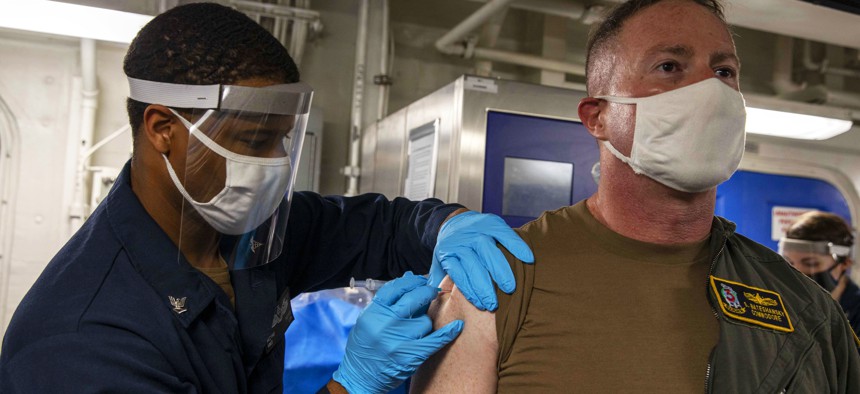
DoD
Fewer Troops Are Declining the COVID Vaccine. We May Never Know Why
Defense leaders say education efforts and seeing peers get vaccinated are reducing the reluctance.
Anyone in the Defense Department who wants a COVID vaccine will become eligible on April 19 and able to get one by mid-May, defense officials said on Thursday. And fewer appear to be declining the shots.
DoD does “not track declinations,” Maj. Gen. Jill K. Faris of U.S. Army Medical Command said during a Thursday press conference, reiterating the Pentagon’s stance on a question that has come up repeatedly since February reports that around one-third of troops were declining the vaccine.
But Faris said officials are seeing “an overall trend in a positive way with more people accepting the vaccine.”
“As the vaccines have been around, as people are getting vaccinated, we’re seeing an increase in those who take the vaccine,” Faris said. “We believe that’s due in large part to the education and the materials we put out — information that our clinicians are able to push out via social media, giving information at town halls, and pushing it to commanders to answer questions that service members might have.”
But DoD still does not know exactly who wants the vaccine and why those who decline do so.
“We don’t have a system in place across the services to specifically track data for those individuals who for whatever reason are declining or deferring the vaccine,” Pentagon spokesman John Kirby said at a briefing in February.
Even after a House Armed Services Committee hearing where it was suggested that the DoD had more data than it was sharing with the public, the Pentagon again reinforced that the data did not exist.
“Nobody is hiding data,” Kirby said in February when asked about the HASC testimony. “There’d be no reason for us to hide data when we can tell you exactly how many people are getting the vaccines. If there’s something more that was testified today, I promise I will get it to you, but nobody is trying to hide anything here.”
Vaccination rates differ from service to service. Over 50% of the Navy’s eligible population and 35% of its active-duty force has been vaccinated with the distribution of around 650,000 doses. The Air Force has distributed around 499,000 shots total to provide 11.1% of its total population with at least a first dose. And the Army has distributed around 688,000 total shots thus far.
“It took 70 days to administer the first million vaccines, 35 days for the next million, and with more than a quarter of a million doses administered in the last 8 days we're on track for the next million in somewhere between twenty-five and thirty days,” Defense Health Agency Directory Lt. Gen. Ronald Place said Thursday.
Despite increases in acceptance rates, the vaccine remains strictly voluntary for all troops regardless of pending deployments to sea or foreign countries.
“It is a voluntary vaccination,” Faris said. “However, prior to deploying we provide the opportunity for all individuals to have access to be able to be vaccinated. It is not a mandatory requirement for readiness.”
Biden was urged at the end of last month to make the vaccine mandatory for troops — a power that rests solely with the president. Rep. Jimmy Panetta, D-Calif., wrote a letter saying that vaccinating service members was a matter of “readiness.” The letter was signed by six additional House Democrats. So far, the vaccine remains optional.
“If we’re deployed on board a ship we still continue to do all the public health measures we've been doing for the last year — wearing masks, social distancing — so they still would go on deployment,” Navy deputy surgeon general Rear Adm. Gayle Shaffer said.
“Our people are paying attention and coming in for vaccination,” Place said. “We’re thankful to those who have taken that step...We’re turning the corner in our country and in the DoD.”
